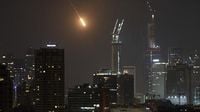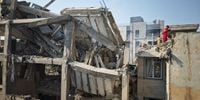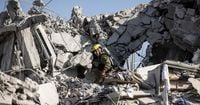On June 13 and 14, 2025, the Middle East witnessed a dramatic and deadly escalation in the long-standing conflict between Israel and Iran, marking the most intense exchange of fire between the two nations in decades. Early Friday morning, Israel launched a massive and unprecedented airstrike campaign targeting Iranian nuclear and military sites, killing more than 70 people, including several top commanders of Iran’s security apparatus. This bold offensive, according to the Israel Defense Forces (IDF), was designed to cripple Iran’s nuclear ambitions and military capabilities, but it also unleashed a fierce retaliatory missile and drone barrage from Iran that struck deep into Israeli territory, killing at least three Israelis and injuring dozens more.
The Israeli operation, which began in the early hours of June 13, resulted in the deaths of over 20 commanders within Iran’s security establishment. Among those killed were Gholam-Reza Marhabi, considered Iran’s most senior intelligence officer; Mohammad Bagheri, commander of the Islamic Revolutionary Guard Corps (IRGC) Surface-to-Surface Missile Array; and Amir Ali Hajizadeh, the IRGC Air Force Commander. The IDF highlighted Bagheri’s critical role in overseeing Iran’s surface-to-surface and cruise missile capabilities and his involvement in orchestrating attacks on Israel in April and October 2024. Hajizadeh and several senior officials were reportedly killed during an Israeli strike on an underground military headquarters in Tehran.
The Israeli strikes did not stop at military personnel. State media in Iran reported that nine senior scientists and experts involved in the Iranian nuclear program were also killed, including Ali Bakaei Karimi, Mansour Asgari, and Saeid Borji. These assassinations underscored Israel’s intent to disrupt Iran’s nuclear progress, which it perceives as an existential threat. The strikes targeted nuclear facilities at Natanz and Isfahan, with the United Nations’ nuclear watchdog confirming severe damage to the aboveground enrichment plant at Natanz. However, the main underground centrifuge facility at Natanz and the deeply buried Fordow nuclear site reportedly remained intact. The International Atomic Energy Agency (IAEA) stated there was no increase in off-site radiation levels following the attacks, calling any radiological leaks “manageable.”
Iran’s response was swift and severe. In the hours following Israel’s attacks, Iran launched approximately 200 ballistic missiles and numerous drones targeting Israeli cities including Tel Aviv and Jerusalem. Air-raid sirens blared across Israel as residents rushed to bomb shelters. Despite Israel’s advanced missile defense systems intercepting many projectiles, at least three Israelis were killed, and dozens were injured in missile strikes, including a deadly attack in Rishon Lezion that wounded 21 people, with one later succumbing to injuries. The Israeli Defense Minister, Israel Katz, issued a stark warning to Iran’s leadership, declaring that if missile attacks continued, “Tehran will burn,” signaling a readiness to escalate the conflict further.
On the Iranian side, the casualties were far heavier. Iranian officials reported at least 78 killed and over 320 wounded in Israeli strikes, many of them civilians. One particularly devastating attack hit the Shahid Chamran residential complex in Tehran, a defense ministry residential building, killing an estimated 60 people, including 20 children. Explosions were also reported in other Iranian cities such as Tabriz, and the Iranian capital remained on high alert with air defenses activated and ongoing Israeli strikes targeting missile sites and military installations, including Tehran’s Mehrabad airport.
The conflict has not only caused tragic loss of life but also disrupted civilian life and regional infrastructure. Ben Gurion International Airport in Israel remains closed, and neighboring countries like Iraq, Jordan, and Syria have closed their airspaces amid the heightened tensions. Major airlines canceled or rerouted flights to avoid the conflict zones, with airlines like Emirates, Lufthansa, and Delta suspending flights to and from the region. The airspace closures have affected an estimated 3,000 flights, showcasing the broad ripple effects of the conflict on global travel and commerce.
Complicating the situation further, Iran has threatened to attack military bases of countries supporting Israel, including the United States, France, and the United Kingdom. Iranian state media warned that any nation assisting in intercepting Iranian strikes on Israel would be considered a co-belligerent, with military installations and naval vessels in the Persian Gulf and Red Sea becoming targets. This ominous declaration has raised fears of a wider regional war that could draw in global powers.
Diplomatically, the timing of the Israeli strikes has severely undermined ongoing nuclear negotiations between Iran and the United States. The two sides were scheduled to meet on June 15, 2025, in Muscat, Oman, for a sixth round of talks aimed at curbing Iran’s nuclear program. However, Iran’s Ministry of Foreign Affairs spokesperson Esmaeil Baghaei declared the talks “meaningless” in light of Israel’s attacks and accused the U.S. of complicity, stating, “Participating in talks with a party that is the principal supporter and accomplice of the aggressor is fundamentally meaningless.” While Iran has not formally canceled the talks, it remains unclear if it will attend, casting a shadow over the diplomatic process.
The United States’ role in the conflict remains ambiguous. While Israeli officials reportedly hoped for U.S. participation in the strikes, Secretary of State Marco Rubio denied direct American involvement. Nonetheless, President Donald Trump and his administration have expressed support for Israel and moved military assets to the region to protect American interests. Trump also urged Iran to negotiate, warning that failure to do so would result in “more brutal attacks.”
On the ground, the human toll and psychological impact are profound. In Israel, thousands spent nights in bomb shelters, with many describing the experience as frightening and disruptive to daily life. In the West Bank, where Palestinians lack bomb shelters and early warning systems, residents faced heightened vulnerability, with reports of injuries from falling shrapnel. In Tehran, residents described the shock and fear as explosions rocked the city, with many civilians caught in the crossfire. Journalists and activists reported scenes of devastation, including families fleeing burning buildings and children traumatized by the violence.
Experts warn that the Israeli strikes have exposed significant intelligence and defense gaps within Iran. Senior Iranian officials reportedly did not anticipate the timing or scale of the attack, with some commanders ignoring directives to shelter in safe locations. The killing of top military leaders and scientists has created a leadership vacuum that could hinder Iran’s ability to respond effectively or recover swiftly. Yet, analysts caution that this could also push Iran toward accelerating its nuclear weapons program, abandoning diplomatic efforts in favor of a more aggressive stance.
International voices have called for calm amid the escalating crisis. United Nations Secretary-General António Guterres urged an immediate end to the hostilities, emphasizing that “peace and diplomacy must prevail.” Pope Leo XIV also appealed for de-escalation, calling on leaders to pursue dialogue and respect to build lasting peace and security for all in the region.
As the conflict continues to unfold, the world watches anxiously. The strikes have not only inflicted heavy casualties and damage but have also raised the specter of a broader regional war. With both nations digging in and no clear path to de-escalation, the coming days promise to be fraught with danger and uncertainty, underscoring the fragile and volatile nature of Middle Eastern geopolitics in 2025.






